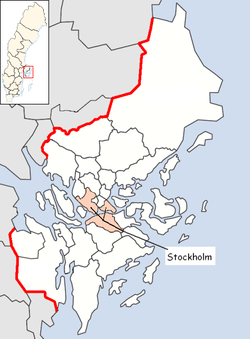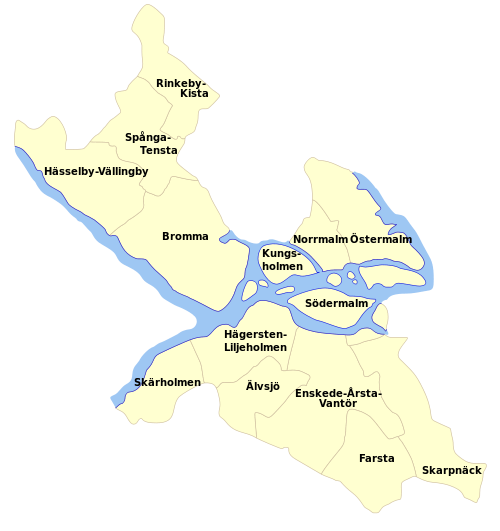Stockholm Municipality
| Stockholm Municipality Stockholms kommun | ||
|---|---|---|
| Municipality | ||
| ||
 | ||
| Country | Sweden | |
| County | Stockholm County | |
| Seat | Stockholm | |
| Government | ||
| • Mayor | Karin Wanngård (Social democrats) | |
| Area[1] | ||
| • Total | 214.63 km2 (82.87 sq mi) | |
| • Land | 187.17 km2 (72.27 sq mi) | |
| • Water | 27.46 km2 (10.60 sq mi) | |
| Area as of January 1, 2014. | ||
| Population (June 30, 2016)[2] | ||
| • Total | 928,122 | |
| • Density | 4,300/km2 (11,000/sq mi) | |
| Time zone | CET (UTC+1) | |
| • Summer (DST) | CEST (UTC+2) | |
| ISO 3166 code | SE | |
| Province | Uppland and Södermanland | |
| Municipal code | 0180 | |
| Website | www.stockholm.se | |
Stockholm Municipality or the City of Stockholm (Swedish: Stockholms kommun or Stockholms stad) is a municipality in Stockholm County in east central Sweden. It has the largest population of the 290 municipalities of the country, but one of the smallest areas, making it the most densely populated. It is also the most populous municipality in the Nordic countries.
Although legally a municipality with the official proper name Stockholms kommun, the municipal assembly (kommunfullmäktige) has decided to use the name Stockholms stad (City of Stockholm in English) whenever possible. This is purely nominal and has no effect on the legal status of the municipality.
Geography
Geographically, Stockholm Municipality comprises the central part of the capital (Innerstaden or Stockholm City Centre) as well as the southern and western suburban parts (Söderort or South Stockholm and Västerort or West Stockholm respectively). Of the municipal population, all but 200 people are considered living in the Stockholm urban area, a tätort further extending into ten other municipalities.
History
When the first local government acts came into force in Sweden in 1863, Stockholm was one of the then 89 cities of Sweden. A first City Council was elected. The area roughly corresponded with today's Innerstaden. Large areas were annexed in 1913, 1916 and 1949. The city was outside Stockholm County until 1968, having its own governor. The local government reform of 1971 made Stockholm a unitary municipality like all others in the country.
Politics
The municipality is governed by a Municipal assembly (kommunfullmäktige) with 101 members. These are elected through municipal elections, held in conjunction with the Parliamentary elections every four years. The council meets twice a month and the meetings are open to the public. The council elects a Municipal executive committee (kommunstyrelse), with 13 members representing both the political majority and the opposition, with the responsibility of implementing policies approved by the assembly. The political organisation also includes eight governing full-time Commissioners (borgarråd) and four Commissioners representing the opposition. The work is headed by the Commissioner of Finance (finansborgarråd, sometimes called Mayor), who also chairs the executive committee. The current Commissioner of Finance is Karin Wanngård, representing the Social democrats.
| Following the 2014 municipal elections, the seats are divided in the following way: | ||||
| The governing parties | Parties in opposition | |||
|---|---|---|---|---|
| The Social Democrats | 24 | The Moderate Party | 28 | |
| The Left Party | 10 | The Liberal People's Party | 9 | |
| The Green Party | 16 | The Christian Democrats | 2 | |
| The Feminist Initiative | 3 | The Centre Party | 3 | |
| The Sweden Democrats | 6 | |||
| Following the 2010 municipal elections, the seats are divided in the following way: | |||
| The governing parties | Parties in opposition | ||
|---|---|---|---|
| The Moderate Party | 38 | The Social Democrats | 25 |
| The Liberal People's Party | 10 | The Left Party | 8 |
| The Christian Democrats | 1 | The Green Party | 16 |
| The Centre Party | 3 | ||
| Following the 2006 municipal elections, the seats are divided in the following way: | |||
| The governing parties | Parties in opposition | ||
|---|---|---|---|
| The Moderate Party | 39 | The Social Democrats | 27 |
| The Liberal People's Party | 10 | The Left Party | 9 |
| The Christian Democrats | 3 | The Green Party | 10 |
| The Centre Party | 1 | ||
| Following the 2002 municipal elections, the seats were divided in the following way: | |||
| The governing parties | Parties in opposition | ||
|---|---|---|---|
| The Social Democrats | 35 | The Moderate Party | 27 |
| The Left Party | 11 | The Liberal People's Party | 17 |
| The Green Party | 6 | The Christian Democrats | 5 |
Municipal elections 1994-2006
| Year | Moderate Party | Christian Democrats | Centre Party | Liberals | Stockholm Party | Green Party | Social Democrats | Left Party | others | ||||||||||||||||||
| Votes | % | Seats | Votes | % | Seats | Votes | % | Seats | Votes | % | Seats | Votes | % | Seats | Votes | % | Seats | Votes | % | Seats | Votes | % | Seats | Votes | % | Seats | |
| 1994 | 128 975 | 28,7 | 29 | 9 399 | 2,1 | 0 | 24 329 | 5,4 | 5 | 35 437 | 7,9 | 9 | 15 309 | 3,4 | 2 | 35 120 | 7,8 | 8 | 148 684 | 33,0 | 37 | 41 274 | 9,2 | 11 | 11 533 | 2,5 | 0 |
| 1998 | 146 797 | 32,9 | 35 | 28 320 | 6,4 | 6 | 9 187 | 2,1 | 0 | 34 789 | 7,8 | 9 | 19 561 | 4,4 | 3 | 26 347 | 5,9 | 6 | 114 118 | 25,6 | 28 | 54 663 | 12,3 | 13 | 20 411 | 4,5 | 0 |
| 2002 | 121 405 | 26,0 | 27 | 20 746 | 4,4 | 5 | 5 939 | 1,2 | 0 | 73 736 | 15,7 | 17 | 9 137 | 1,9 | 0 | 24 965 | 5,3 | 6 | 149 871 | 32,0 | 35 | 52 325 | 11,2 | 11 | 8 772 | 1,8 | 0 |
| 2006 | 180 207 | 37,3 | 41 | 18 907 | 3,9 | 3 | 15 205 | 3,1 | 1 | 46 657 | 9,6 | 10 | 5 831 | 1,2 | 0 | 44 530 | 9,2 | 10 | 118 129 | 24,4 | 27 | 38 284 | 7,9 | 9 | 16 084 | 2,6 | 0 |
Stockholm Party is a local party, which was represented in the City Council 1979-2002.
Municipal Election 2014
On September 9th 2014 Stockhlolm held Municipality Election
| Party | Votes | Seats | ||||
|---|---|---|---|---|---|---|
| Number | % | +/− | Number | +/− | ||
| The Moderate Party | 158 450 | 28,15 | −8,57 | 28 | −10 | |
| The Social Democrats | 128 086 | 21,96 | −0,64 | 24 | −1 | |
| The Green Party | 83 561 | 14,32 | +0,45 | 16 | +/−0 | |
| The Left Party | 52 146 | 8,94 | +1,50 | 10 | +2 | |
| The Liberal People's Party | 48 302 | 8,28 | −1,74 | 9 | −1 | |
| The Sweden Democrats | 30 078 | 5,16 | +2,53 | 6 | +6 | |
| The Centre Party | 27 369 | 4,69 | +0,72 | 3 | +/−0 | |
| The Feminist Initiative | 27 079 | 4,64 | +3,48 | 3 | +3 | |
| The Christian Democrats | 19 125 | 3,28 | −0,21 | 2 | +1 | |
| Other parties | 9 137 | 1,57 | +1,12 | 0 | +/−0 | |
| Total | 583 333 | 100,00 | +/−0 | 101 | +/−0 | |
Board of Commissioners since 2006
- Sten Nordin (m), Commissioner of Finance (after 2008) (finansborgarråd)
- Mikael Söderlund (m), Commissioner of Building and Traffic (byggnads- och trafikborgarråd)
- Ulla Hamilton (m), Commissioner of Environment and Real Estate (miljö och bostadsbolagsborgarråd)
- Lotta Edholm (fp), Commissioner of Education (skolborgarråd)
- Madeleine Sjöstedt (fp), Commissioner of Culture and Sports (kulturborgarråd)
- Kristina Alvendal (m), Commissioner of Housing and Integration (bostads- och integrationsborgarråd)
- Ulf Kristersson (m), Commissioner of Social Services (socialborgarråd)
- Ewa Samuelsson (kd), Commissioner of Senior Citizen's Service (äldrevårdsborgarråd)
- Carin Jämtin (s), Commissioner in Opposition (oppositionsborgarråd)
- Roger Mogert (s), Commissioner in Opposition (oppositionsborgarråd)
- Ann-Margarethe Livh (v), Commissioner in Opposition (oppositionsborgarråd)
- Yvonne Ruwaida (mp), Commissioner in Opposition (oppositionsborgarråd)
District Councils

The municipality is subdivided into 14 districts. These districts are sometimes incorrectly referred to as "boroughs" in English. They are, however, no legal entities or juristic persons of their own, but committees of the municipality itself. These districts are administered by District Councils, stadsdelsnämnder, which carry responsibility for primary school, social, leisure and cultural services within their respective areas. The members of these councils are not directly elected by the inhabitants of the respective districts, but rather appointed by the kommunfullmäktige (municipal assembly).
Effective January 1, 2007 the number of district councils was reduced from 18 to 14 through a number of merges. Maria-Gamla stan and Katarina-Sofia now form Södermalm borough, Enskede-Årsta and Vantör now form Enskede-Årsta-Vantör, Hägersten and Liljeholmen now form Hägersten-Liljeholmen, and Kista and Rinkeby now form Rinkeby-Kista.
| Stockholm City Centre | South Stockholm | West Stockholm |
|---|---|---|
Twin Towns - Sister Cities
The policy of Stockholm is to have informal town twinning with all capitals of the world, its main focus being those in northern Europe. Stockholm does not sign any formal town twinning treaties, although the city claims to have established such treaties in the past which are still valid.[3]
The cities claiming to have been twinned with Stockholm are:
References
- ↑ "Statistiska centralbyrån, Kommunarealer den 1 januari 2014" (Microsoft Excel) (in Swedish). Statistics Sweden. Retrieved 2014-04-18.
- ↑ "Folkmängd i riket, län och kommuner 30 juni 2016" (in Swedish). Statistics Sweden. August 17, 2016. Retrieved August 17, 2016.
- ↑ "Internationell strategi" – Stockholm Stads official website
- ↑ Twinning Cities: International Relations. Municipality of Tirana. www.tirana.gov.al. Retrieved on 2008-01-25.
- ↑ "Fraternity cities on Sarajevo Official Web Site". © City of Sarajevo 2001-2008. Retrieved 2008-11-09.
- ↑ "Saint Petersburg in figures - International and Interregional Ties". Saint Petersburg City Government. Retrieved 2008-10-23.
- ↑ "Riga municipality portal". Riga.lv. 2008-05-20. Archived from the original on December 4, 2008. Retrieved 2009-05-06.
External links
| Wikimedia Commons has media related to Stockholm Municipality. |
Coordinates: 59°21′N 18°04′E / 59.350°N 18.067°E
